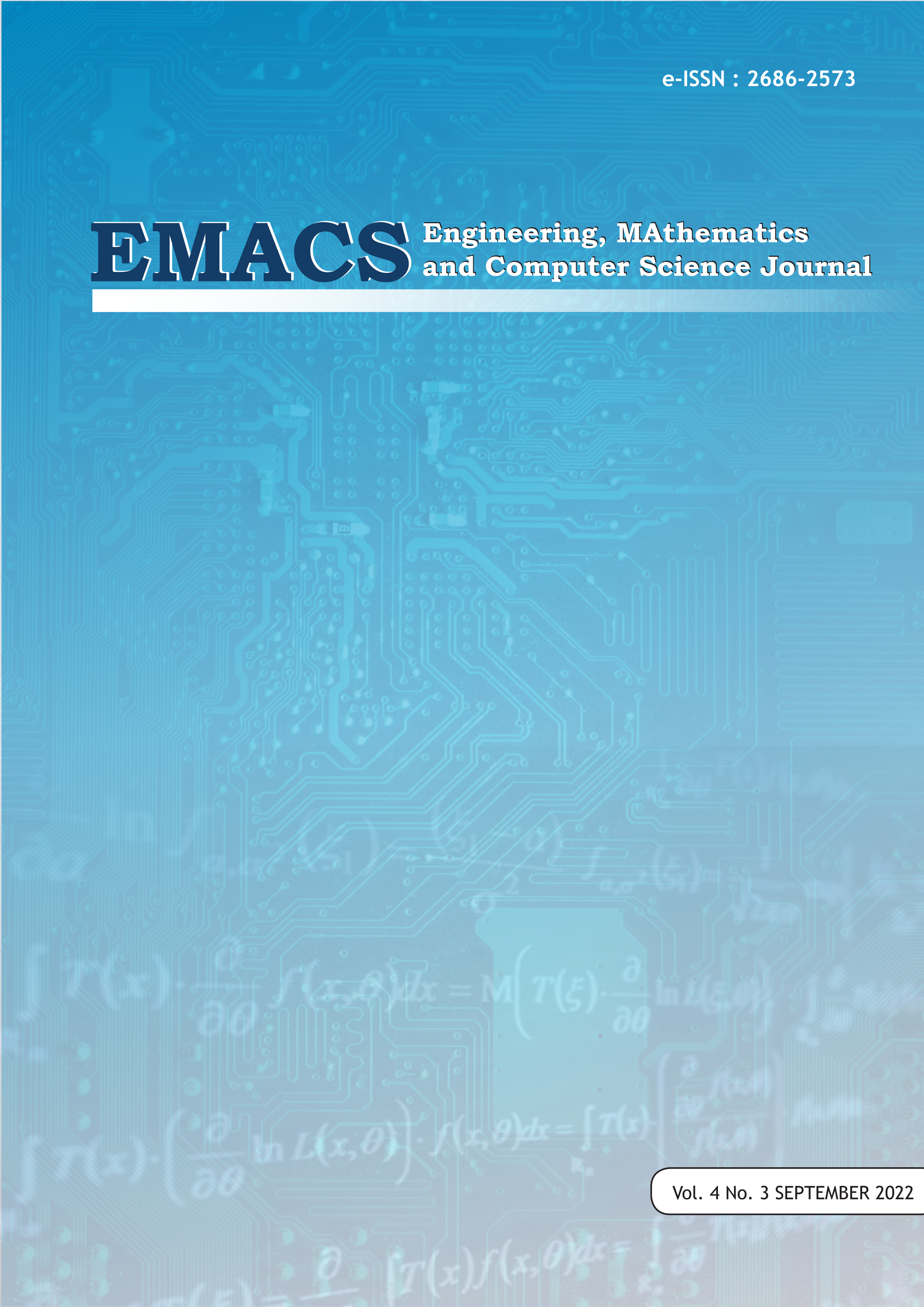Comparing SVM and Naïve Bayes Classifier for Fake News Detection
DOI:
https://doi.org/10.21512/emacsjournal.v4i3.8670Keywords:
Fake news, Machine learning, SVM, Naïve Bayes, ClassificationAbstract
Fake news has been evolving into a problem that is getting even more challenging. Technology has been misused to spread false information about many things, such as war, pandemics, and the stock market. Unfortunately, this issue is not a big deal for some people without conscious consumption of that news. Hence, being part takes a role in combating the spread of false information using the advancement of technology. This study proposed two methods of machine learning model, Support Vector Machine (SVM) and Naïve Bayes, to classify fake news. Furthermore, to assert the applicability of models by examining news articles dataset which contain two labels, reliable and unreliable news. The higher accuracy is 0.96 using the SVM model
References
Ahmad, I., Yousaf, M., Yousaf, S., & Ahmad, M. O. (2020). Fake News Detection Using Machine Learning Ensemble Methods. Complexity, 2020, 1–11. https://doi.org/10.1155/2020/8885861
Ahmed, A. A. A., Aljabouh, A., Donepudi,P. K., & Choi, M. S. (2021). Detecting Fake News Using Machine Learning: A Systematic Literature Review.
Aldwairi, M., & Alwahedi, A. (2018). Detecting Fake News in Social Media Networks. Procedia Computer Science, 141, 215–222. https://doi.org/10.1016/J.PROCS.2018.10. 171.
AlShariah, N. M., & Khader, A. (2019). Detecting Fake Images on Social Media using Machine Learning. International Journal of Advanced Computer Science and Applications, 10(12). https://doi.org/10.14569/IJACSA.2019.010 1224.
ArunKumar, K., Preethi, G., & Vasanth, K. (2020). A Study of Fake News Detection using Machine Learning Algorithms. International Journal of Technology and Engineering System (IJTES), 11(1), 1–7.
Cassauwers, T. (2019, April 15). Can artificial intelligence help end fake news? Horizon Magazine.
Chauhan, T., & Palivela, H. (2021). Optimization and improvement of fake news detection using deep learning approaches for societal benefit. International Journal of Information Management Data Insights, 1(2), 100051. https://doi.org/10.1016/J.JJIMEI.2021.100 051.
Chen, M., Chu, X., & Subbalakshmi, K. P. (2021). MMCoVaR: Multimodal COVID- 19 Vaccine Focused Data Repository for Fake News Detection and a Baseline Architecture for Classification.
Divya Tiwari, & Surbhi Thorat. (2021). Terrorism And Fake News Detection. International Journal of Scientific Research in Computer Science, Engineering and Information Technology, 313–323. https://doi.org/10.32628/CSEIT217670.
Farokhian, M., Rafe, V., & Veisi, H. (2022, April 10). Fake news detection using parallel BERT deep neural networks.
Hancock, J. T., Curry, L. E., Goorha, S., & Woodworth, M. (2007). On Lying and Being Lied To: A Linguistic Analysis of Deception in Computer-Mediated Communication. Discourse Processes, 45(1), 1–23. https://doi.org/10.1080/016385307017391 81.
Humayoun, M. (2022). The 2021 Urdu Fake News Detection Task using Supervised Machine Learning and Feature Combinations.
Jain, A., Shakya, A., Khatter, H., & Gupta, A. K. (2019). A smart System for Fake News Detection Using Machine Learning. 2019 International Conference on Issues and Challenges in Intelligent Computing Techniques (ICICT), 1–4. https://doi.org/10.1109/ICICT46931.2019. 8977659.
Kaggle. (2018). Fake News. Kaggle. Available: https://www.kaggle.com/competitions/fake-news/data. [Accessed: 25-Jun-2022].
Lai, C.-M., Chen, M.-H., Kristiani, E.,Verma, V. K., & Yang, C.-T. (2022). Fake News Classification Based on Content Level Features. Applied Sciences, 12(3), 1116. https://doi.org/10.3390/app12031116
Pandey, S., Prabhakaran, S., Subba Reddy, N. v, & Acharya, D. (2022). Fake News Detection from Online media using Machine learning Classifiers. Journal of Physics: Conference Series, 2161(1), 012027. https://doi.org/10.1088/1742- 6596/2161/1/012027.
Pavlyshenko, B. M. (2022). Methods of Informational Trends Analytics and Fake News Detection on Twitter.
Rashkin, H., Choi, E., Jang, J. Y., Volkova, S., & Choi, Y. (2017). Truth of Varying Shades: Analyzing Language in Fake News and Political Fact-Checking. Proceedings of the 2017 Conference on Empirical Methods in Natural Language Processing, 2931– 2937. https://doi.org/10.18653/v1/D17-1317.
Shu, K., Sliva, A., Wang, S., Tang, J., & Liu, H. (2017). Fake News Detection on Social Media: A Data Mining Perspective.
Torabi Asr, F., & Taboada, M. (2019). Big Data and quality data for fake news and misinformation detection. Big Data & Society, 6(1), 205395171984331. https://doi.org/10.1177/2053951719843310
Webb, G. I. (2016). Naïve Bayes. In Encyclopedia of Machine Learning and Data Mining (pp. 1–2). Springer US. https://doi.org/10.1007/978-1-4899-7502- 7_581-1.
Zhou, X., Zafarani, R., Shu, K., & Liu, H. (2019). Fake News. Proceedings of the Twelfth ACM International Conference on Web Search and Data Mining, 836–837. https://doi.org/10.1145/3289600.32913.
Downloads
Published
How to Cite
Issue
Section
License
Copyright (c) 2022 Engineering, MAthematics and Computer Science (EMACS) Journal

This work is licensed under a Creative Commons Attribution-ShareAlike 4.0 International License.
Authors who publish with this journal agree to the following terms:
- Authors retain copyright and grant the journal right of first publication with the work simultaneously licensed under a Creative Commons Attribution License - Share Alike that allows others to share the work with an acknowledgment of the work's authorship and initial publication in this journal.
- Authors are able to enter into separate, additional contractual arrangements for the non-exclusive distribution of the journal's published version of the work (e.g., post it to an institutional repository or publish it in a book), with an acknowledgment of its initial publication in this journal.
- Authors are permitted and encouraged to post their work online (e.g., in institutional repositories or on their website) prior to and during the submission process, as it can lead to productive exchanges, as well as earlier and greater citation of published work.
USER RIGHTS
All articles published Open Access will be immediately and permanently free for everyone to read and download. We are continuously working with our author communities to select the best choice of license options, currently being defined for this journal as follows: Creative Commons Attribution-Share Alike (CC BY-SA)





